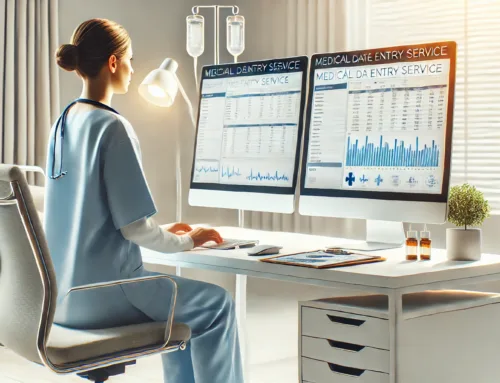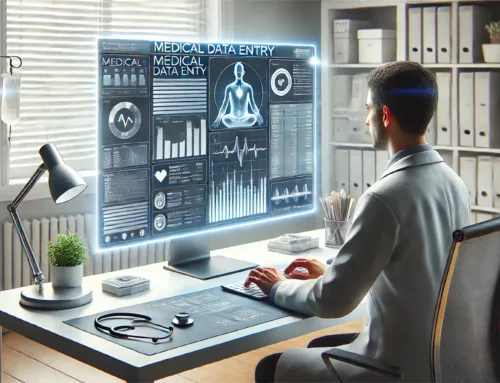When it comes to navigating the intricate world of medical data entry, understanding the ten key services offered in medical data entry is crucial for maintaining operational efficiency and accuracy in healthcare institutions. From patient information management to surgical records data entry, each service plays a vital role in ensuring seamless operations and quality patient care. With technological advancements constantly reshaping the healthcare landscape, staying informed about these essential services can significantly impact the success and effectiveness of healthcare providers.
Patient Information Entry
When it comes to managing patient information in the healthcare industry, efficient and accurate data entry is paramount. Patient record accuracy is crucial for providing quality care and ensuring patient safety. Data security measures must also be strictly adhered to in order to protect sensitive information.
Utilizing advanced data entry software can streamline the process of entering patient information, reducing the risk of errors and improving efficiency. This software often includes features that help validate data entry to ensure accuracy and completeness. Additionally, proper data entry training is essential for staff to effectively use the software and adhere to data security protocols.
Medical Billing Entry
When it comes to medical billing entry, accuracy is paramount in ensuring that claims are processed correctly. Timely submission of claims is crucial for healthcare facilities to receive payments promptly and maintain a steady cash flow. By focusing on accuracy in billing and timely claim submission, healthcare providers can streamline their revenue cycle management and improve overall financial efficiency.
Accuracy in Billing
To ensure accurate medical billing entry, meticulous attention to detail is paramount. Billing error prevention is crucial in this process, as even minor mistakes can lead to significant financial discrepancies. Thorough insurance verification ensures that the correct information is submitted for billing, reducing the chances of claim denials and delays.
Utilizing electronic health records enhances accuracy by centralizing patient information and streamlining the billing process. However, it is essential to prioritize patient confidentiality throughout, safeguarding sensitive data from unauthorized access or breaches.
Timely Claim Submission
Ensuring timely claim submission is a critical aspect of efficient medical billing entry. It is essential to submit claims promptly to avoid claim denial and ensure a smooth reimbursement process. Electronic submission plays a key role in expediting this process, allowing for quicker processing and reducing the chances of errors that could lead to claim denial.
By submitting claims electronically, providers can track the progress of each claim through an audit trail, which provides a detailed history of the submission process. This audit trail is invaluable in identifying any issues that may arise during the submission process, allowing for prompt resolution and resubmission if necessary.
Timely claim submission not only speeds up the reimbursement process but also minimizes the risk of claim denial due to missed deadlines or incomplete information. By leveraging electronic submission and maintaining a thorough audit trail, medical billing entry services can ensure that claims are processed efficiently and accurately, ultimately leading to improved financial outcomes for healthcare providers.
Medical Coding Entry
The process of medical coding entry plays a crucial role in accurately translating medical procedures, diagnoses, and services into universal alphanumeric codes for billing and record-keeping purposes. Coding accuracy is paramount in ensuring that healthcare providers are appropriately reimbursed for services rendered. Compliance regulations set by governing bodies like HIPAA require meticulous attention to detail in medical coding to protect patient information and maintain ethical billing practices.
Medical coding entry involves assigning specific codes to diagnoses, procedures, and supplies used during patient encounters. These codes are essential for insurance claims processing, reimbursement, and statistical analysis within healthcare facilities. Ensuring coding accuracy is vital to prevent claim denials, audits, and potential legal issues due to incorrect billing practices. Compliance regulations mandate that medical coders stay up-to-date with changes in code sets and guidelines to accurately reflect the services provided.
Medical Insurance Claim Forms Entry
Medical Insurance Claim Forms Entry is a significant aspect of the healthcare billing process, seamlessly connecting the detailed coding work to the reimbursement phase. Claim processing efficiency is crucial in ensuring timely payments from insurance companies. By accurately inputting data from medical insurance claim forms, you facilitate a smooth transition from service provision to reimbursement. Data entry accuracy is paramount to avoid claim rejections and delays in payment. Ensuring that all information is correctly entered into the system enhances the overall efficiency of the billing process. Mistakes in data entry can lead to claim denials, impacting the revenue cycle of healthcare providers. Therefore, meticulous attention to detail is essential when handling medical insurance claim forms. By focusing on accuracy and efficiency in claim processing, you contribute to the financial health of healthcare organizations and help maintain a seamless flow of revenue.
Prescription Medication Data Entry
When managing prescription medication data entry, accuracy and attention to detail are paramount. Ensuring prescription dosage accuracy is crucial to avoid potential medication errors that could harm patients. Data entry specialists play a vital role in accurately inputting medication names, dosages, frequencies, and administration routes into electronic systems.
Moreover, these professionals must be vigilant in flagging medication interaction warnings. By diligently checking for potential interactions between different medications, they help prevent adverse drug reactions that could jeopardize patient safety. This meticulous review process involves cross-referencing new prescriptions with a patient’s existing medication regimen to identify any possible conflicts.
Prescription medication data entry requires precision and thoroughness to maintain the integrity of patient records and support safe healthcare practices. By adhering to strict protocols and guidelines, data entry specialists contribute to the overall quality of care provided to patients. Their meticulous work ensures that healthcare providers have accurate and up-to-date information to make informed decisions regarding patient treatments.
Medical Records Data Entry
When it comes to medical records data entry, accuracy is paramount. Ensuring that every detail is entered correctly is crucial for providing quality healthcare. Additionally, maintaining the confidentiality of patient records is a top priority to uphold ethical standards in the medical field.
Accuracy in Data Entry
Ensuring precision and accuracy in data entry is paramount when it comes to managing medical records. The data verification process plays a crucial role in maintaining the integrity of medical information. By double-checking entries for errors or inconsistencies, healthcare providers can minimize the risks associated with inaccurate data. Utilizing efficient data entry software further enhances accuracy by streamlining the input process and reducing the likelihood of manual errors. These software solutions often include built-in validation checks and data quality controls to ensure that information is entered correctly the first time.
Inaccurate medical records can lead to serious consequences, such as incorrect treatment plans, billing errors, or compromised patient safety. By prioritizing accuracy in data entry, healthcare facilities can improve the quality of care provided to patients and enhance overall operational efficiency. Regular training on data entry best practices and quality assurance protocols can also help staff members maintain high standards of accuracy in medical record keeping.
Confidentiality of Records
To uphold the integrity of medical records, the confidentiality of patient information is a non-negotiable aspect of data entry in healthcare settings. Data security measures play a crucial role in ensuring that sensitive patient data is protected from unauthorized access or breaches. Compliance regulations, such as HIPAA in the United States, set strict guidelines for the handling of patient information to maintain confidentiality.
In medical data entry, robust data security measures are implemented to safeguard patient records. Encryption techniques are often utilized to secure data both in transit and at rest. Access controls and user authentication protocols help limit access to authorized personnel only, reducing the risk of data breaches.
Compliance regulations mandate that healthcare providers adhere to strict guidelines regarding patient confidentiality. Regular audits and assessments are conducted to ensure that data entry processes meet these regulatory standards. Training programs are also essential to educate staff on the importance of maintaining patient confidentiality in data entry practices.
Clinical and Healthcare Data Entry
Efficient clinical and healthcare data entry is essential for maintaining accurate patient records and ensuring seamless healthcare operations. To achieve this, robust data security measures must be implemented to safeguard sensitive patient information. Integration with Electronic Medical Record (EMR) systems is crucial for streamlining data entry processes and ensuring that patient records are up-to-date and easily accessible to healthcare providers.
By incorporating stringent data security measures, such as encryption protocols and access controls, healthcare organizations can protect patient confidentiality and comply with regulations like HIPAA. Integration with EMR systems allows for seamless data flow between different healthcare departments, reducing errors and improving overall efficiency in medical data entry.
Accurate clinical and healthcare data entry is vital for providing high-quality patient care, facilitating timely decision-making, and enhancing the overall patient experience. By prioritizing data security and integrating with EMR systems, healthcare providers can optimize their data entry processes and deliver superior healthcare services.
Hospital Records Data Entry
In the realm of healthcare data management, the meticulous handling of hospital records stands as a pivotal task in maintaining the integrity of patient information and streamlining operational processes. Hospital records data entry plays a crucial role in ensuring accurate and up-to-date electronic health records management.
Effective hospital records data entry involves implementing robust data security measures to safeguard patient confidentiality and comply with regulations like HIPAA. This includes utilizing encryption techniques, access controls, and regular audits to prevent unauthorized access or data breaches.
Accuracy is paramount in hospital records data entry, as errors can have serious consequences for patient care and treatment decisions. By meticulously transcribing medical data into electronic systems, healthcare providers can access comprehensive patient histories and make informed decisions quickly and efficiently.
Furthermore, efficient hospital records data entry contributes to improved communication among healthcare professionals, enhances care coordination, and ultimately leads to better patient outcomes. By prioritizing electronic health records management and stringent data security measures, healthcare facilities can optimize their operations and provide high-quality care to their patients.
Medical Image Data Entry
When it comes to medical image data entry, understanding the image format requirements is crucial for accurate storage and retrieval. Quality control measures play a significant role in ensuring that the entered data is precise and reliable for medical professionals to interpret. By adhering to strict protocols regarding image formats and implementing rigorous quality checks, medical image data entry services can streamline the process and enhance the overall efficiency of healthcare systems.
Image Format Requirements
To ensure seamless integration and accurate processing of medical images, adhering to specific image format requirements is crucial. When scanning medical images, ensure high resolution and proper color depth to maintain clarity. Data accuracy verification should be conducted to confirm that patient information matches the images. Implement data encryption standards to protect sensitive medical data from unauthorized access or breaches. Adhere to image file naming conventions that indicate patient details, date of the scan, and any other relevant information for easy retrieval and organization. Following these image format requirements ensures that medical images are securely stored, easily accessible, and compatible with various medical systems. By maintaining these standards, healthcare providers can effectively manage and utilize medical image data for accurate diagnosis and treatment planning.
Quality Control Measures
Adhering to quality control measures in medical image data entry is imperative for ensuring the accuracy and reliability of patient information within healthcare systems. Data validation processes play a crucial role in verifying the integrity of medical image data entered into electronic health records. These processes involve cross-referencing data against established standards and guidelines to confirm its accuracy and completeness. By implementing robust data validation procedures, errors such as missing or incorrect patient information can be identified and rectified promptly, minimizing the risk of adverse outcomes due to inaccuracies in medical records.
Error detection techniques are another vital aspect of quality control in medical image data entry. These techniques involve utilizing automated software algorithms to scan for anomalies or inconsistencies in the entered data. Through error detection mechanisms, discrepancies in medical images, patient demographics, or diagnostic reports can be promptly flagged for review and correction. This proactive approach helps ensure that the data entered is of high quality and aligns with the stringent standards required for effective healthcare management.
Surgical Records Data Entry
With the increasing volume of surgical procedures being conducted worldwide, the accurate and efficient entry of surgical records is paramount for healthcare facilities. Surgical records data entry plays a crucial role in documenting surgical outcomes and maintaining electronic health records.
Ensuring precise data entry for surgical records is essential for tracking patient progress, evaluating surgical outcomes, and identifying any potential complications or trends. By accurately entering information such as surgical procedures performed, post-operative care details, and patient progress notes into electronic health records, healthcare providers can better monitor patient recovery and make informed decisions about future treatments.
Efficient surgical records data entry also facilitates seamless information sharing among healthcare professionals, enabling effective collaboration and continuity of care for patients. Timely and accurate documentation of surgical records not only enhances patient safety but also improves overall healthcare quality by providing a comprehensive overview of each surgical intervention.
Frequently Asked Questions
Do Medical Data Entry Services Ensure Patient Confidentiality?
Yes, medical data entry services ensure patient confidentiality by implementing robust data security protocols and compliance measures. Your sensitive information is carefully safeguarded against unauthorized access, maintaining the highest standards of privacy and protection.
How Are Errors in Medical Data Entry Corrected and Prevented?
You know, errors in medical data entry are no joke. To keep things on track, your team implements robust quality assurance measures. Through meticulous checks and ongoing training, errors are corrected swiftly and prevented diligently.
Is Training Provided for Medical Data Entry Software Usage?
Yes, training is provided for medical data entry software usage. This ensures efficiency in data input and retrieval. Emphasis is placed on accuracy and quality control measures to minimize errors, enhancing overall data management processes.
Can Medical Data Entry Services Handle Multiple Languages?
Absolutely! Medical data entry services offer remarkable language translation capabilities, allowing for seamless handling of multiple languages. They provide exceptional multilingual support, ensuring accurate and efficient data entry across diverse linguistic requirements.
Are Medical Data Entry Services Compliant With HIPAA Regulations?
Yes, medical data entry services ensure compliance with HIPAA regulations for data security, confidentiality, and accuracy. Your sensitive medical information is safeguarded through strict adherence to HIPAA guidelines, guaranteeing confidentiality and accuracy in data handling.




